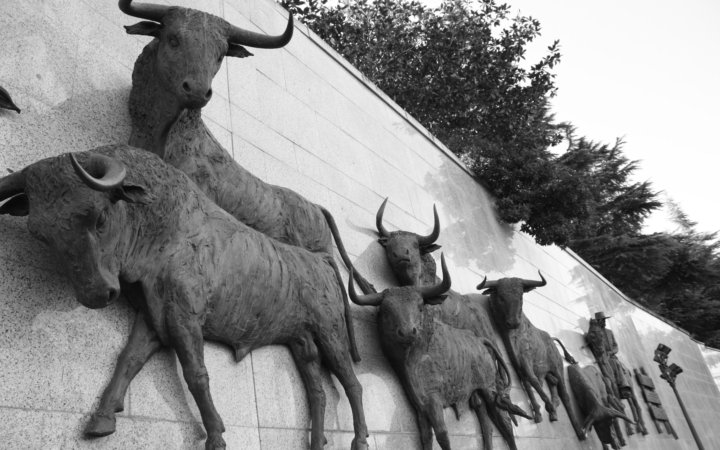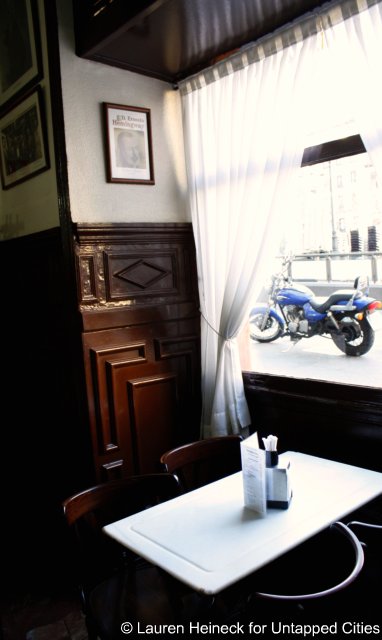I recently watched an episode of Anthony Bourdain’s ”˜The Layover’ as he visited my old territory of Los Angeles. One segment showed Bourdain touring the streets of LA with a professional tour guide mastered in the subject of Hollywood’s darker side-celebrity deaths and their death places-perhaps most notably Black Dahlia, John Belushi, Janis Joplin and Charles Manson’s victims.
It’s true that often we travel not just to take in the city, but to relive it, sometimes as we would have imagined it when [enter dead celebrity here] was alive. The human obsession with morbidity and mystery is reflected in travel highlights like the Tower of London, The Roosevelt Hotel, the toilet at Graceland…the lists goes on and on.
This leads me to a hunch as to why people come to Spain. Sure, the sun, food, architecture, vibrant culture and flamenco guitar melodies attract many, but I’m convinced others do so to combine their interest in stepping foot where famous acts and figures in history spent their last days; where the Spanish Inquisition (one of the most tortuous examples of human mistreatment, persecution and prejudice) took place, or the death and final resting place of Christopher Columbus, or maybe even an interest in the life of Roy Kinnear (you know, that British comedian who spoiled Veruca Salt rotten in Willy Wonka?). And lest we forget Ernest Hemingway, who left his footprints well marked throughout the Spanish state, and has likely inspired millions of tourists to become aware of Spanish culture or make the pilgrimage themselves to visit his old stomping grounds. Simply uttering the name “Hemingway” is likely to conjure up many images for the Western Literature fan, or anyone who paid attention in their high school English Lit class. For many others, this name probably draws upon imagery of Paris, the Caribbean, Spain, bullfighting, and of course, alcohol. The latter three can all be found in Madrid-and still visible and accessible-through Hemingway’s trail.
Hemingway was no stranger to Europe, his novels are dotted with inspiration from his time in Italy, Paris, and London (although not always by choice-living through two world wars), but Madrid was a city that he always came back to, including one of his final international trips before his suicide in 1961.
Who’s to say exactly why “Don Hemingway,” as the Spaniards called him, became so enamored by Madrid? We may always just wonder what drew him back during the hard times, a civil war, the beginning of a dictatorship and later between trips to his other permanent residencies. Some of his most active literary years were those that he spent in the Spanish capital, predominately in the mid-1920s and mid-1950s.
An eccentric and extroverted ex-pat, he was known to visit and return to his passion points, or to bars that leaked Republican news (those of the anti-fascist movement). More than fifty years since his death, you can still wander through the skinny cobblestone alleys, lean against the dark wood and marble-laden bars or sit in the shade at the famed bullring.
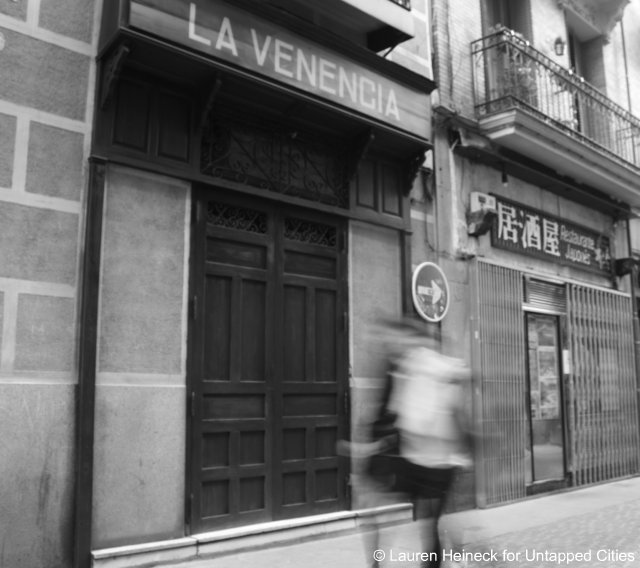 La Venencia on Calle de Echegaray in the barrio of Huertas
La Venencia on Calle de Echegaray in the barrio of Huertas
Begin at the epicenter of Madrid, kilometro cero, from which all of the corners of Spain sit equidistant, officially known as the Puerta del Sol. This is the old part of town-the historic district-so it won’t be difficult to put yourself into Hemingway’s shoes from here. Cut right onto a less crowded side section and soon you’ll find yourself on the quiet street of Calle de Echegaray. The painted block letters above door number seven will read La Venencia. Go inside and ask for a glass or tasting of jerez-sherry wine fortified with brandy and a typical apéritif-maybe you’ll hear your neighbor discussing Republican democracy, or simply sit and enjoy, whether that be while mourning or celebrating his legacy.
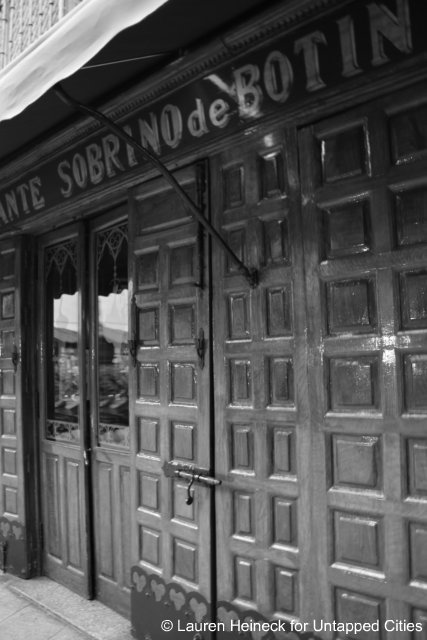 Front entrance to El Sobrino de Botin on Calle de los Cuchilleros
Front entrance to El Sobrino de Botin on Calle de los Cuchilleros
Stumble out into the callejones Madrileà±os that seem to be frozen in time and direct yourself towards Restaurante Sobrino de Botin, or just Botin to the locals. According to the Guinness Book of World Records, it is the oldest working restaurant in the world. Dating back to 1725, this restaurant witnessed many an afternoon and evening with Mr. Hemingway. He chose this site as a point of interest in his novel The Sun Also Rises, in which the protagonists share a meal here. His “table” remains on the upper level, essentially as he would have left it, so many years ago.
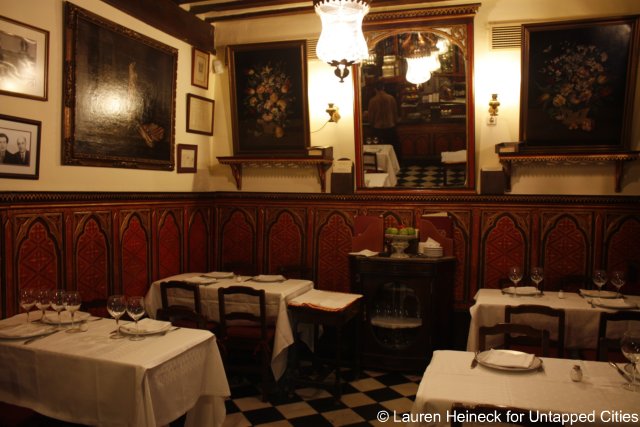 Downstairs dining room at Botin
Downstairs dining room at Botin
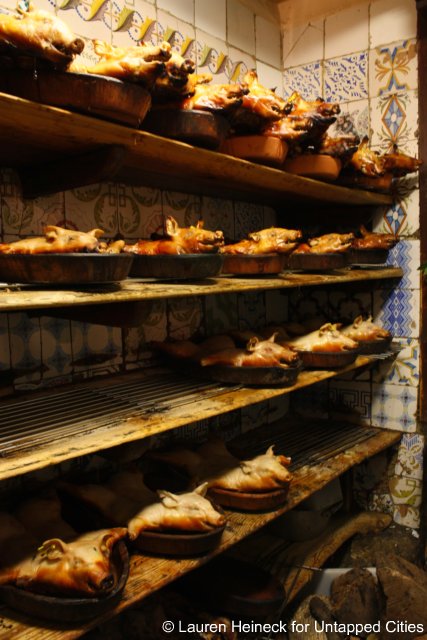 Roasted suckling pigs awaiting their turn inside the 300 year old oven at Botin
Roasted suckling pigs awaiting their turn inside the 300 year old oven at Botin
If necrophobia is the fear of dead things and things associated with death, then perhaps necrogastrophobia would be the fear that you will die before trying quintessential dishes that famous people had dined on before you. If that’s your thing, order the roasted suckling pig (cochinillo) and a glass of rioja alta wine. PETA advocates have been forewarned-these little piggies won’t be going all the way home.
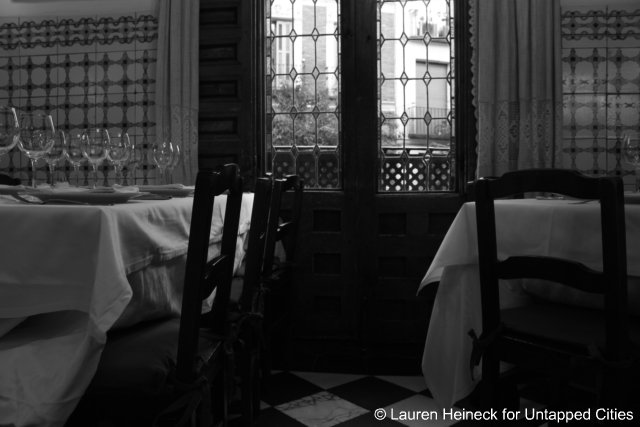 Or choose the upstairs dining room where Hemingway preferred to sit
Or choose the upstairs dining room where Hemingway preferred to sit
After dinner, mosey uphill towards Gran Via, the busy and well-lit intersection of the city, lined with early 20th century facades, brimming with locals, out-of-towners and theater-goers. Grab a nightcap at Museo Chicote, known in Hemingway’s day as Taberna Chicote-it was, and still is hip, modern, art-deco and classic. Drinks are strong and the design is well-kept, cheers to authenticity! For the record, other deceased celebrities walked through these doors and sipped these cocktails including: Rita Hayworth, Grace Kelly, Frank Sinatra and Orson Welles.
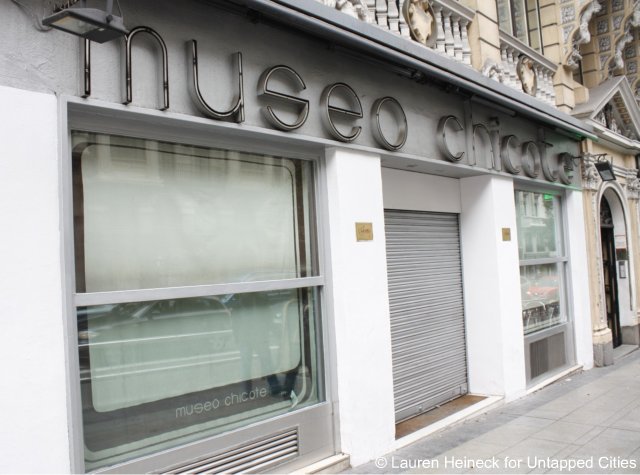 A classic bar stop on Madrid’s busy Gran Via
A classic bar stop on Madrid’s busy Gran Via
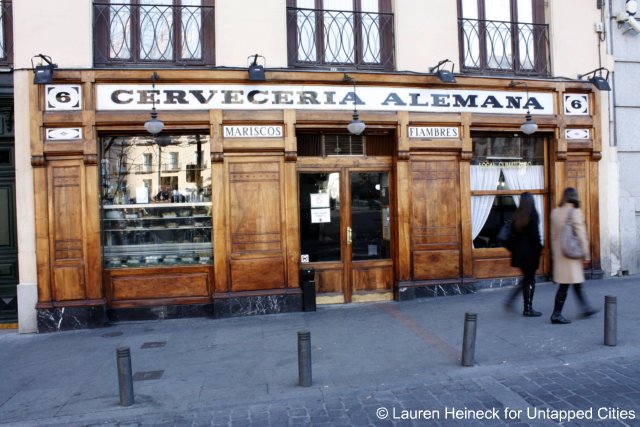 In Hemingway’s day La Cerveceràa Alemana served one of Madrid’s best beers on tap
In Hemingway’s day La Cerveceràa Alemana served one of Madrid’s best beers on tap
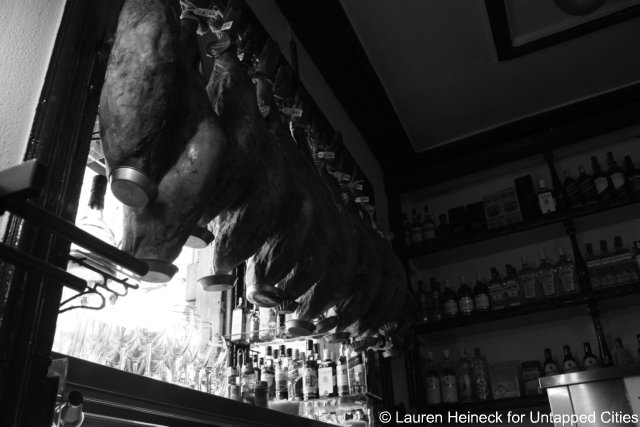 What Spanish pub isn’t equipped with cured ham legs and strong liquors?
What Spanish pub isn’t equipped with cured ham legs and strong liquors?
If the night must live on, or if the next morning you find yourself needing a hangover cure with a slice of history, pop into Cerveceràa Alemana in Plaza Santa Ana. Perhaps these folks play too heavily on the “Hemingway was here” catchphrase, but alas for all those retracing his steps, this bar/restaurant shouldn’t be overlooked. The inside holds to its past and one can marvel at the jamón legs from the marble counter-top or steal his spot in the window for people watching and that touch of nostalgia. Bring your copy of Death in the Afternoon his non-fiction writing on bullfighting and courage, or For Whom the Bell Tolls, his interpretation of the Spanish Civil War. Have no fear, the bartenders won’t kick you out until you want to leave.
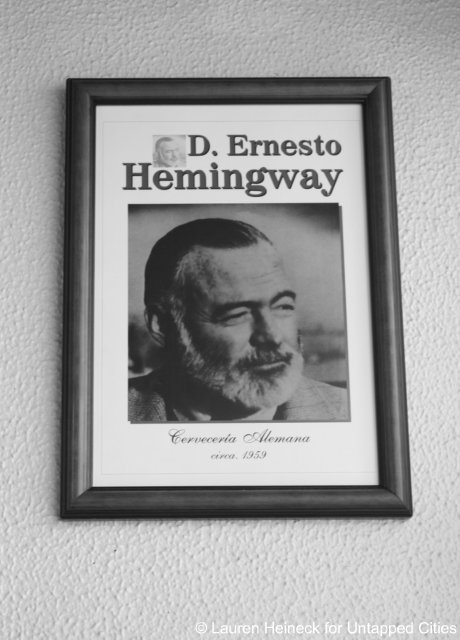
In Madrid for the weekend? You can follow Hemingway’s lead to the Plaza de Toros de Las Ventas. Every Sunday from the beginning of March until the end of October tourists, Madrileà±os and Spaniards (generally of the older generation) mark their space inside the nearly 24,000 seat arena to partake in the viewing pleasure, or disgust, of bullfighting.
The subject is very touchy here in Spain (Catalonia banned the practice in 2011) as to whether or not in today’s society it is an art form, animal cruelty, or dying tradition, but the truth is that Ernest Hemingway was a passionate enthusiast of the “sport.” You can still find many tapas bars serving up rabo de toro, a stewed bull’s tail, which comes from-you guessed it-the final act of the bullring.
For architecture fans, Las Ventas is worthy of a trip to see the blend of Muslim and southern Spanish styles on a grand scale. Inaugurated in 1931, it’s no surprise that this impressive construction, as well as literal execution inside and out, must have deeply impacted Hemingway.” ª
I challenge you not to feel swept away by your surroundings as you spend a day in the life of Hemingway in Madrid. Enjoy!
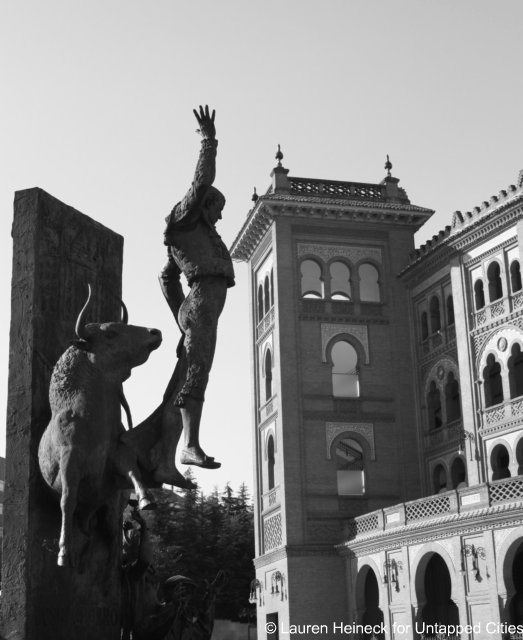 Many flock to the outer areas of the bullring for picture taking and gawking
Many flock to the outer areas of the bullring for picture taking and gawking
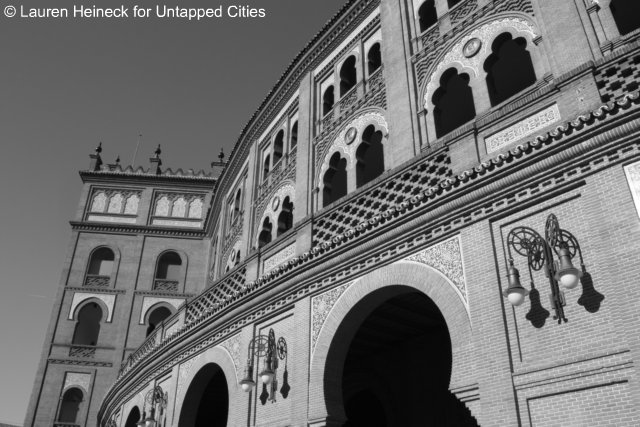 Carefully placed bricks, ironwork and tiles line the circumference
Carefully placed bricks, ironwork and tiles line the circumference
La Venencia [map]
Calle de Echegaray 7
28014 Madrid Spain
Restaurante Sobrino de Botin [map]
Calle de los Cuchilleros 17
28005 Madrid Spain
Museo Chicote [map]
Gran Via 12
28013 Madrid Spain
Ceverceràa Alemana [map]
Plaza Santa Ana 6
28012 Madrid Spain
Plaza de Toros Las Ventas [map]
Calle Alcalá 237
28028 Madrid Spain
Follow Untapped Cities on Twitter and Facebook! Get in touch with the author @jamon_y_vino






